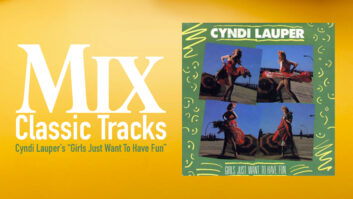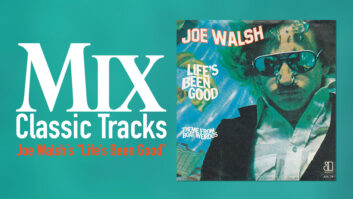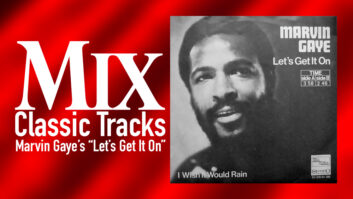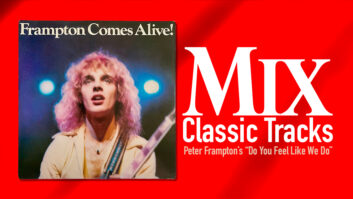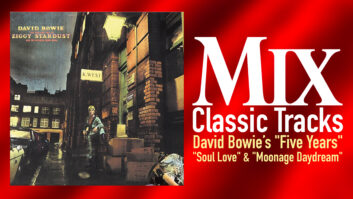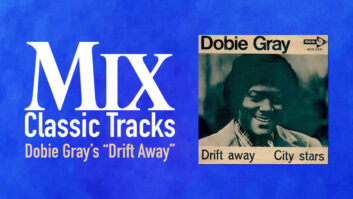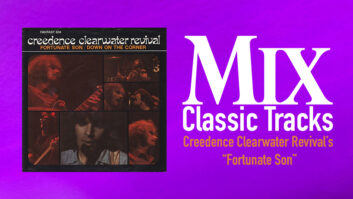
Oingo Boingo emerged as part of L.A.’s punk/new wave scene during the late 1970s, led by Danny Elfman and incorporating ska and electronica into their music, albeit differently from other “alternative” bands of the time. Their sound was dramatic, outrageous and constantly changing, reflecting their weird, semi-musical beginnings.
The band was spawned by the Mystic Knights of the Oingo Boingo, a surrealist theater troupe that was formed in 1972 by Richard Elfman. When Richard decided to depart and pursue a career in film, his brother Danny took the wheel. The project evolved into a musical theater group, and finally into the band Oingo Boingo by about 1979.
In 1980, Oingo Boingo released a self-titled EP that included “Only a Lad,” which would become the title track on the band’s first full-length album the following year. Three more albums dropped in three more years, a period that saw the departure of two bandmembers: bass player Kerry Hatch and keyboardist Richard Gibbs.
By 1984 Elfman, guitarist Steve Bartek and drummer Johnny “Vatos” Hernandez, along with new members John Avila (bass) and Mike Bacich (keys), were experimenting increasingly with electronic sounds and different tempos, and Elfman’s involvement in film music was developing, too.
Elfman wrote the title song for the John Hughes movie Weird Science, which Oingo Boingo recorded at Sound Factory Studios (L.A.) with engineer David Leonard and assistant Bill Jackson, and mixed with Leonard at Capitol. The idea was for the song also to appear on their next album, which they intended also to make with Leonard. However, Leonard needed to move on to another project, so he recommended his assistant for the job.
“One day, David walked up to me and says, ‘I told Danny I can’t work with them and that they should use you,’” Jackson recalls. “Next thing, I get a call from Danny and he says, ‘David says that we should use you to do the record. Are you good with that?’ I said, ‘Oh yeah, sure.’ At this point, I had not engineered any label projects, except for occasional overdubs. I’d mostly been doing demos.”
Jackson had originally made his way to L.A. from his hometown in South Carolina, via San Francisco. As a boy, he’d developed a fascination with music and recording. As a young man, he played in bands and recorded friends’ projects to help pay for his education at Coastal Carolina College. He wanted to take his engineering skills to the next level but wasn’t sure how.
“One time, the band I was in played an out-of-town gig, which we didn’t do very often. We were in a little town where there was nothing to do, but there was a magazine stand downtown, so I went over there to find some music magazines. I saw something that made my jaw drop. It was Mix magazine, and it had an article written by Tom Lubin where he interviewed Fred Catero. In that article, Lubin talked about working at the College for Recording Arts in San Francisco. I was like, there’s a school?”
Jackson sold almost everything he owned and moved across the country. When he’d completed his year-long course at the College of Recording Arts, he moved to L.A. and eventually got his first job at Sunset Sound, which soon after acquired Sound Factory. Staff members would move between the two facilities, helping wherever they were needed.
“I would also come early and stay late, and I would hang out in the studio with anybody that would let me,” Jackson says. “Back then, there were three sessions in the day and up to three sessions at night. I would look at everything that they were doing and all of the gear in the chain. I got to observe people like Al Schmitt recording Toto and Donn Landee mixing Van Halen. And sometimes if an engineer wasn’t available, they’d say, ‘Use Bill. He knows what he’s doing.’ But Oingo Boingo was the first time this happened for a big album project.”
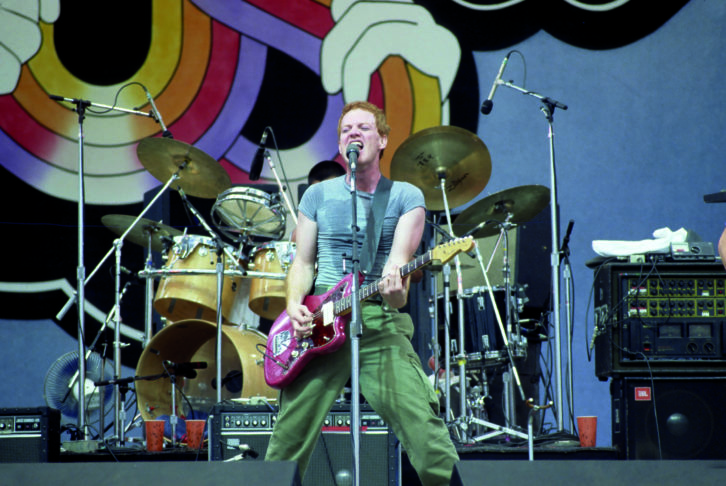
Setting Up at Sound Factory
The equipment for the Dead Man’s Party sessions, in Sound Factory Studio A, was set up under Leonard’s supervision beforehand, but choices were tweaked as the album progressed.
“We recorded everything live, even if we were just trying to get the drums, and that’s something I ended up carrying out through most of the records I ever did,” Jackson says. “When you’re recording the band, it’s much easier to figure out if something doesn’t work—if the drummer’s just a little too slow, or maybe he should do something for one more measure.”
Hernandez’s drums were set up on risers in a corner that was the typical drum location in Studio A. “Steve Bartek and Danny would be at the console in the control room with me, with a Sennheiser 441 on Danny’s vocal. He’d be playing his guitar, but his amp and Steve’s amp were miked up with Neumann U47 FETs in a smaller room off of the live room.”
Avila’s bass was captured with a Countryman DI, supplemented by a Neumann U87 on his amp, which was situated in its own room, behind the control room. “I remember the keyboard player [Bacich] was facing me, and I remember they used an Emulator I on those live sessions. Everything went down at once, even the sequenced parts.”
On drums—the main object of the live sessions—Jackson recalls that there was another 47 FET on the kick. “That’s something I learned from David, who did ‘Weird Science,’ though sometimes we would use a Sennheiser 421 if we were trying to get a little more dynamic presence,” he says. “Snare was a Shure SM57, probably with an AKG 452 with a 10dB pad underneath. Hat was probably a 452 with a 20dB pad, and toms I think were probably AKG C414s, which I believe was David’s thing at the time.”
Later, during overdubs, the bandmembers would replace any parts they weren’t content with, and Jackson captured Elfman’s lead vocals, as well as Elfman’s and Avila’s backing vocals, with an AKG C12a. “I always used the same one,” Jackson says. “That went into a Teletronix LA-2A compressor, and we used the 550A EQ from the API console to add some top end.”
The band also overdubbed further percussion pieces and synth parts, such as the arpeggiated intro to “Just Another Day” that repeats throughout the song. Jackson kindly checked with Bartek, who recalls that part was a Yamaha DX7 playing a custom balafon setting that Elfman had edited.
“That sequenced keyboard and the little percussion hits that I think they did on the Emulator I—that’s what I think of when somebody says ‘Oingo Boingo,’” Jackson says. “And it’s the way Danny holds out the notes, with that great echo that Michael Frondelli put on there, and it breaks down to the drums and a sequencer. That song has everything that made them great.”
Mixing at Capitol
Michael Frondelli mixed the entire Dead Man’s Party album in Capitol Studio C. Dead Man’s Party was one of his early projects at Capitol as a recent transplant from New York, and the sessions included a quintessential California experience:
“We were mixing—Danny, Steve Bartek and I—in Studio C, and all of a sudden I saw this look of horror on everyone’s faces,” Frondelli recalls. “I said, ‘What happened? Did I do something wrong?’ They said, ‘It’s an earthquake.’ Danny and I went outside and we saw telephone poles swaying. It hadn’t registered with me at first because I’d worked in New York for so long, including nine years as a staff engineer at Electric Lady, which is at subway level. You feel that rumble and you don’t think about it.”
Capitol became Frondelli’s Los Angeles base of operation, including 11 years as vice president of Capitol Studios, so he only needed to listen back to “Just Another Day” once to recall most of the ingredients that went into his mix.
“On guitars, we used Pultecs—MEQ5s or EQP1A3s,” Frondelli says. “This was something that I got into the habit of doing with the Neve 8108 console in C, because it could be a little harsh. On the bass, I used dbx 160 VUs, to keep a tight bottom in the rhythm track. Capitol also had a Neve sidecar, and I used 31105 [pre/EQ].”
On the vocal treatment that Jackson mentioned, Frondelli employed Capitol’s Fairchild 660 along with Roland SDE 3000 delay. “I also used a Publison Infernal Machine 90 for a little bit of chorusing on the vocal. That also had settings where you could put in delays, so I would split the output [the vocal] in stereo left-right, 25 or 35 milliseconds, and add it to the mono vocal source just to give it a little bit of ambience. You can hear when you listen to that song, the ambient sounds are short; it’s not a long echo trail on it. I liked the echo trail with the delay, but I also like Danny’s vocal up-front because his lyrics and his delivery are succinct and they need to be clear.”
Classic Tracks: Cheap Trick’s “Surrender”
Frondelli also recalls using a dbx 500 Series de-esser for sibilance on Elfman’s vocal, as well as the Neve 31105 to fatten the sound. “Danny had a pretty big midrange peak somewhere around the 2k range,” Frondelli says. “You want to be able to smooth it out and get warmth out of his vocal with clarity, with some air on the top.
On the kick drum, Frondelli remembers using the 31105 along with a Neve 33609 compressor/limiter. “Same thing with the snare,” he says. “There was an insert point on the console where I could put a chain inside it and bypass the EQ. So [on snare] there would be the 31105, probably followed by a Pultec EQP1A3. I’m not positive but I probably also limited the snare before the Pultec with a UREI 1176LN, and then I would use a little bit of the harmonic distortion from the Pultec that gave the spray on that snare.
“And then I think for the rest of the kit I was using the 8108 EQs, probably with some parallel compression on the drum kit,” Frondelli continues. “I would send a post-EQ drum submix into a stereo UREI 1178 and then bring it back through two faders into the mix. Again using a UREI 1176LN, I parallel-limited the vocal, too; I was in a habit of doing this back then—parallel-limiting the sidechain with a highly compressed vocal so that when you brought the mix down to a lower volume, the vocal would still speak without being too overbearing. This helped for radio, and because this was in Walkman days, your mix had to be about the headphones people listened on.”
Frondelli listened back on his own Yamaha NS10 speakers, powered by the studio’s Hafler amps, and Elfman would also take cassettes out to his car for an extra reality check.
“What we always worked at was creating atmosphere and layers of depth,” Frondelli says.
“I would make sure we carved out space in the frequency spectrum for certain instruments to speak, mostly to frame the vocal, because the vocals have to tell the story.”
More Than Just Another Day
And the story? Listen back to track one on Dead Man’s Party. “Just Another Day” turns out to be more timeless than one might have imagined in 1985:
I feel it all around,
I feel it in my bones,
My life is on the line,
When I’m away from home.
When I step out the door,
The jungle is alive
I do not trust my ears,
I don’t believe my eyes.
I will not fall in love,
I cannot risk the bet,
Cause hearts are fragile toys,
So easy to forget.
It’s just another day…
Dead Man’s Party became Oingo Boingo’s most successful album, reaching Number 95 on Billboard’s albums chart. “Just Another Day” was one of several songs on the album that was used in a film soundtrack; it is featured as the opening theme in the film That Was Then… This Is Now (1985), and later was used in an episode of the Netflix series Stranger Things that takes place in the mid-’80s.
Bill Jackson worked on all four of Oingo Boingo’s remaining albums. His other music credits include Los Lobos’ Number One cover of “La Bamba,” as well as their Grammy-winning soundtrack to the film Desperado (1995). Like Elfman, Jackson eventually shifted to film sound work. In fact, he received a job offer from Todd/AO while he was still in the remote-recording truck for Oingo Boingo’s Farewell live album. His sound-for-picture credits include recording Elfman’s music for The Nightmare Before Christmas and Midnight Run, and serving as a re-recording mixer for the TV show Entourage, which earned him an Emmy Award for Outstanding Sound Mixing.
Michael Frondelli’s credits span decades, from his days in New York engineering Crowded House and Billy Idol to revitalizing Capitol Studios in L.A. and beyond. His resume also includes soundtrack work on the John Hughes film The Breakfast Club, Joe Jackson’s Big World, working with Keith Richards on Chuck Berry’s film Hail Hail Rock’n’Roll and producing and engineering the self-titled smash debut by Big Bad Voodoo Daddy. These days he concentrates on the hip catalog collections released by Coolsville Music, the music-licensing company he operates with partners Gary Stamler and Brad Benedict, and he gives back by producing the Light Up the Blues benefit concerts for Autism Speaks with Kristen, Stephen and Chris Stills.
Oingo Boingo disbanded in 1995. Elfman, of course, has composed unforgettable scores for multiple Tim Burton films, Marvel Comics movies, and more. His bandmates have also built multifaceted careers, with Bartek notably continuing to collaborate with Elfman as a composer and orchestrator, as well as spearheading his own projects. Meanwhile, Hernandez is the driving force behind the occasional Boingo Dance Party, where former members of the band and their musician friends re-create something a lot like Oingo Boingo whenever the spirit moves them.
